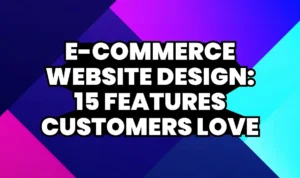Introduction
When it comes to online shopping, your E-Commerce Website Design can make or break a customer’s experience. From the first click to completing a purchase, every element of your website influences conversions and customer satisfaction. Today, we’ll explore 15 essential features of e-commerce website design that customers genuinely love, helping you optimize your online store for maximum engagement and sales.
A well-designed e-commerce site doesn’t just look attractive—it guides users smoothly through the buying journey, enhances trust, and keeps them coming back. Whether you’re building a new store or redesigning an existing one, these features are non-negotiable.
For professional implementation and examples of optimized e-commerce designs, explore our portfolio at DevsKing.

1. Responsive and Mobile-Friendly Design
With over half of online shopping done on mobile devices, a mobile-responsive e-commerce website is a must.
- Adaptive layouts ensure seamless navigation on smartphones and tablets.
- Buttons, menus, and forms are optimized for touch interactions.
- Mobile-first design improves user engagement and Google search rankings.
A responsive site ensures customers can browse and purchase anywhere, increasing sales potential.
2. Fast Loading Speed
Website speed directly impacts conversions. Studies show that even a 1-second delay can reduce sales by up to 7%.
- Optimize images and media for fast loading.
- Use lightweight coding frameworks and reliable hosting like Dronahost Hosting for speed optimization.
- Enable caching and Content Delivery Networks (CDNs) to improve performance globally.
A fast e-commerce website design improves user satisfaction and SEO rankings.
3. Clear and Intuitive Navigation
Navigation is critical for reducing bounce rates and improving user experience:
- Use clear menus with categories and subcategories.
- Implement search functionality with filters for easy product discovery.
- Sticky navigation bars help users access options without scrolling back.
Intuitive navigation keeps users engaged and encourages longer browsing sessions.
4. High-Quality Product Images and Videos
Customers love seeing detailed visuals before making a purchase:
- Multiple high-resolution images showing products from different angles.
- 360-degree views and videos for better product understanding.
- Zoom functionality for detailed inspection.
Visual content builds trust and helps customers make confident purchase decisions.
5. Customer Reviews and Ratings
Social proof is essential for conversions:
- Display product reviews prominently on product pages.
- Include star ratings, testimonials, and user-submitted images.
- Encourage feedback with incentives like discounts or loyalty points.
Customer reviews increase trust and influence potential buyers positively.
6. Secure and Transparent Checkout
A smooth checkout process is vital for reducing cart abandonment:
- Offer multiple payment options (credit cards, PayPal, digital wallets).
- Clearly display shipping fees, taxes, and delivery times.
- Use SSL certificates to ensure secure transactions.
A secure checkout process enhances customer confidence and drives more completed orders.
7. Wishlists and Favorites
Allow customers to save products for later:
- Adds convenience for returning shoppers.
- Encourages repeat visits and potential purchases.
- Provides insights into customer preferences for personalized marketing.
Wishlist features enhance user experience and loyalty.
8. Personalized Recommendations
Leverage AI and customer behavior data to suggest products:
- “Recommended for You” sections increase upselling opportunities.
- Cross-selling related items boosts average order value.
- Personalized recommendations improve engagement and satisfaction.
Integrating personalization into e-commerce website design creates a tailored shopping experience.
9. Easy Returns and Refund Policies
Transparency in returns builds trust:
- Clearly outline your return, exchange, and refund policies.
- Make it easy for customers to initiate returns.
- Highlight guarantees to reduce purchase hesitation.
A customer-centric return process enhances brand reputation and repeat purchases.
10. Live Chat and Customer Support
Instant support increases conversions and reduces frustration:
- Implement live chat for real-time assistance.
- Include chatbots for 24/7 responses to FAQs.
- Offer multiple support channels like email, phone, or social media.
Effective support ensures customers complete their purchases confidently.
11. Advanced Filtering and Sorting Options
Customers want to find products quickly and efficiently. Advanced filtering and sorting features enhance e-commerce website design by:
- Allowing users to filter by size, color, price, brand, and ratings.
- Sorting options like “Best Selling,” “Price Low to High,” or “Newest Arrivals.”
- Improving user satisfaction and reducing frustration while browsing large catalogs.
Enhanced filtering ensures customers find exactly what they need, boosting conversions.
12. Engaging Call-to-Actions (CTAs)
CTAs guide users toward desired actions:
- Use clear, compelling buttons like “Buy Now,” “Add to Cart,” or “Get Yours Today.”
- Position CTAs prominently on product pages, banners, and pop-ups.
- Combine contrasting colors with concise text for maximum visibility.
Effective CTAs increase click-through rates and drive sales.
13. Loyalty Programs and Discounts
Reward loyal customers to encourage repeat purchases:
- Offer points, rewards, or exclusive discounts for returning buyers.
- Showcase promotions on the homepage and product pages.
- Encourage email subscriptions for special deals.
Integrating loyalty programs into e-commerce website design improves customer retention and lifetime value.
14. Seamless Multi-Device Experience
With users shopping across devices, consistency is key:
- Ensure desktop, mobile, and tablet experiences are visually cohesive.
- Keep navigation, product displays, and checkout consistent across platforms.
- Test responsive layouts regularly to avoid broken elements or slow performance.
A seamless experience increases satisfaction, reduces bounce rates, and encourages repeat visits.
15. Analytics and Performance Tracking
Data-driven insights help optimize your e-commerce site:
- Integrate tools like Google Analytics and heatmaps to monitor user behavior.
- Track conversions, bounce rates, and popular product pages.
- Use insights to improve design, navigation, and marketing strategies.
Regularly analyzing data ensures your e-commerce website design evolves with customer preferences.
Advanced Tips for Maximum Conversions
- Optimize Images for Speed: Compressed, high-quality images improve load times without sacrificing visuals.
- Use Professional Hosting: Platforms like Dronahost Hosting ensure high performance and uptime.
- Internal Linking: Guide users to related products, blogs, or FAQs using internal links like our blog or case studies.
- External References: Link to credible resources or partners for authority and trust signals.
Implementing these tips alongside the 15 key features ensures your e-commerce website is both user-friendly and optimized for conversions.
Conclusion
A high-performing e-commerce website is more than just a visually appealing design—it’s a combination of usability, speed, trust, and customer-centric features. By implementing these 15 features of e-commerce website design, you can significantly enhance user experience, improve conversions, and build long-term customer loyalty.
At DevsKing, we specialize in creating e-commerce websites that blend functionality, aesthetics, and conversion-driven strategies. Explore our portfolio or request a consultation to see how we can help craft your perfect online store.
FAQs
- Why is responsive design essential for e-commerce websites?
Mobile users represent a large portion of shoppers, making responsive design critical for accessibility and conversions. - How does website speed affect e-commerce conversions?
Faster websites reduce bounce rates, increase satisfaction, and improve SEO, directly impacting sales. - What is the most important feature for customer trust?
Secure checkout with clear return policies and visible trust badges is essential for building confidence. - Do product videos improve conversions?
Yes, videos provide better product understanding and can significantly increase purchase likelihood. - How can personalization increase sales?
Personalized recommendations and promotions encourage users to buy more, boosting average order value. - Should I use minimal or maximalist design for e-commerce?
Minimalist design works best for clarity and speed, while maximalist design is ideal for immersive, visually-driven stores. - How often should I update my e-commerce website?
Regular updates ensure security, speed, and relevance in design and functionality. - Can internal links improve user experience?
Yes, guiding users to related products, blogs, or FAQs increases engagement and session duration. - Do loyalty programs really boost sales?
Absolutely—loyalty programs encourage repeat purchases and enhance customer retention. - How does DevsKing help with e-commerce websites?
DevsKing designs, develops, and optimizes high-performing e-commerce websites. Explore our portfolio and request a consultation for professional assistance.






